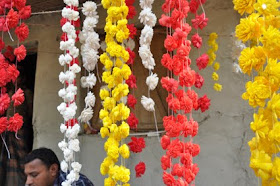
The museum is set within extensive grounds which are used to host an annual Folk Art Festival organised and supported by the museum foundation.

The festival includes an area which has a fairground feel, with entertaining rides and activities, stalls selling food and craft items, people picnicing and playing games.




Tucked away in a box in one of the shops were some clay dolls, like the ones we had seen in the museum.


There is another section of the fair which provides temporary accommodation and workspaces for crafts people to make, demonstrate and sell their crafts during the festival. It was great to see people working a range of materials and processes.
Fan makers.
Traditional wooden toy makers




(We had seen a large papier mache version of the toy horse in Shabag in the morning).

Paper mask makers

Strips of paper and glue are laid over clay models to give the shape, when dry, the paper is removed from the clay mould, trimmed and then painted. The characters are heros and villans from religious and folk tales.


There was a family, three generations, of 'Sholapith' craftworkers making moving toys, ornaments and flowers from shola - the same material that the Hindu wedding hats or coronets were made from which I had been drawing in the museum and seen in Old Dhaka.


I had seen some of the flowers before and had wondered what they were made from and how they had been made. The interest in the coronets made me want to learn more about how the material was worked.
The men had the material in its raw state, aswell as carefully sliced sheets which were made by cutting a continuous slice from around the stem until reaching the core.
 Using few tools, other than two very sharp knifes, a range of skillful and carefully made cuts, combined with a knowledge of and sensitivity to the material resulted in the flowers 'appearing'.
Using few tools, other than two very sharp knifes, a range of skillful and carefully made cuts, combined with a knowledge of and sensitivity to the material resulted in the flowers 'appearing'. 
There is something magical about the process. See the shola being worked and the flowers being made here: 'Sholapith' craftworker.
Another stall was selling baskets and bamboo items including a fan and a bamboo basket similar in shape to the metal ones in the museum.

There was also a blacksmith making the traditional knives used for preparing vegetables in Bangladesh.










